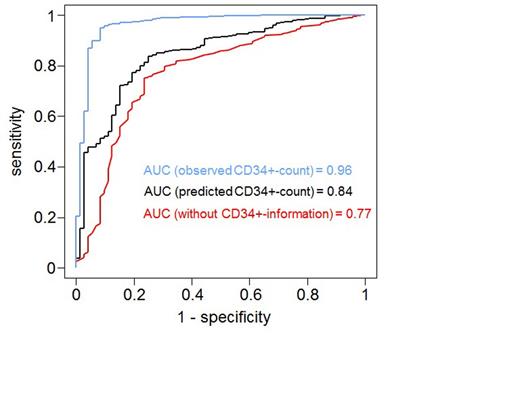Abstract
Introduction:
The collection of hematopoietic stem cells from the peripheral blood in healthy donors has been established as a highly efficient method in clinical practice. Nevertheless, there are some donors who mobilize poorly despite adequate mobilization regimes. Several factors influencing the process of stem cell mobilization have previously been discussed in the literature.
Methods:
In total, the data of 7.216 unrelated donors who underwent GCSF-induced stem cell mobilization and collection in two German apheresis centers between July 1997 and August 2012 were retrospectively reviewed. We systematically analyzed more than 30 factors with potential influence on the mobilization process and established a statistically stable model in order to predict the mobilization efficacy and the harvest success in unrelated stem cell donors.
Based on empirical data and standard values, we created three model donors of each gender with different donor profiles (favorable/average/unfavorable). In those model donors we calculated the corresponding likelihood of a successful stem cell harvest dependent on the recipient’s weight.
Results:
Overall, ten variables with high statistical significance were included in the prediction model. Body mass index, platelet count, absolute lymphocyte count and the relative monocyte count correlated positively with the CD34+ count in the peripheral blood after five days of GCSF use (p < 0.0001 in a multivariate analysis). In contrast, female sex, age, smoking, lactate dehydrogenase (ldh), relative monocyte count, and the relative large unstained cell count were associated negatively with the CD34+ count on day five (p < 0.0001 in a multivariate analysis).
In order to predict the harvest success (collection of > 2 x 10^6 CD34+ cells/kg recipient weight after first apheresis) three different models were compared in a ROC-analysis. The first model was purely based on female sex and recipient weight. The second model additionally contained the predicted CD34+ counts. Finally, in the third model the actual observed CD34+ counts were included.
By adding the predicted CD34+ counts to the simple model, a significant improvement of the predictability of a harvest success could be viewed although a considerable difference comparing these results to the model with the observed CD34+ counts remained (figure 1).
Furthermore, the prediction of harvest success in model donors (figure 2) revealed that donors with a favorable donor profile (covariates set to the most favorable values within the normal range) showed a particular high likelihood for a successful harvest (100 % likelihood, irrespective to donor’s gender or recipient’s weight). The likelihood for a successful harvest in male donors with an average distribution of covariates (covariates set to the empirical mean value) was nearly 100% as well even in donations for heavy recipients. Contrary, the likelihood for an average female donor was high in normal weight recipients (97 %; 60 kg recipient) but decreased with rising recipient weight (78 %; 140 kg recipient).
In donors with an unfavorable profile (covariates set to the worst values within the normal range), especially in females, the chance for a successful stem cell collection was poor even when donating for light recipients (54 % in males, 10 % in females; 60 kg recipient).
Conclusions:
In conclusion, multiple factors with influence on the CD34+ count after GCSF mobilization in healthy donors have been identified. With the prediction model a significant gain in the predictability of a harvest success could be achieved though a certain amount of unexplained variance still remains.
Model donors with a favorable or average donor profile had a high likelihood for a successful stem cell collection. In donors with an unfavorable profile, especially in females, the chance for a harvest success was very low.
Prediction of harvest success (> 2 x 10^6 CD34+ cells/kg recipient weight after 1st apheresis)
Prediction of harvest success (> 2 x 10^6 CD34+ cells/kg recipient weight after 1st apheresis)
Abb.: AUC – area under the curve
Probability of harvest success in model donors (> 2 x 10^6 CD34+ cells/kg recipient weight after 1st apheresis)
Probability of harvest success in model donors (> 2 x 10^6 CD34+ cells/kg recipient weight after 1st apheresis)
Schmidt:Cellex GmbH: Employment. Ehninger:Cellex GmbH: Equity Ownership. Off Label Use: G-CSF.
Author notes
Asterisk with author names denotes non-ASH members.



This feature is available to Subscribers Only
Sign In or Create an Account Close Modal